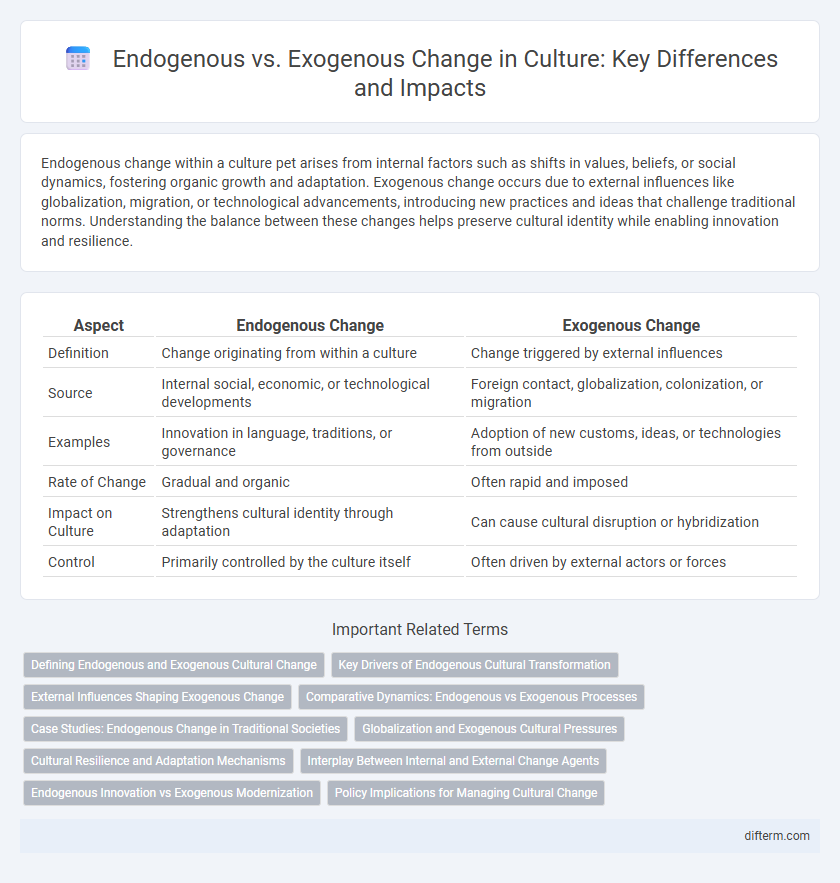Endogenous change within a culture pet arises from internal factors such as shifts in values, beliefs, or social dynamics, fostering organic growth and adaptation. Exogenous change occurs due to external influences like globalization, migration, or technological advancements, introducing new practices and ideas that challenge traditional norms. Understanding the balance between these changes helps preserve cultural identity while enabling innovation and resilience.
Table of Comparison
| Aspect | Endogenous Change | Exogenous Change |
|---|---|---|
| Definition | Change originating from within a culture | Change triggered by external influences |
| Source | Internal social, economic, or technological developments | Foreign contact, globalization, colonization, or migration |
| Examples | Innovation in language, traditions, or governance | Adoption of new customs, ideas, or technologies from outside |
| Rate of Change | Gradual and organic | Often rapid and imposed |
| Impact on Culture | Strengthens cultural identity through adaptation | Can cause cultural disruption or hybridization |
| Control | Primarily controlled by the culture itself | Often driven by external actors or forces |
Defining Endogenous and Exogenous Cultural Change
Endogenous cultural change originates from within a society, driven by internal factors such as shifts in values, beliefs, or social structures. Exogenous cultural change occurs due to external influences like contact with other cultures, technological innovations, or colonization. Understanding these distinctions highlights how cultures evolve through both internal dynamics and outside interactions.
Key Drivers of Endogenous Cultural Transformation
Key drivers of endogenous cultural transformation include generational shifts, evolving values, and internal social dynamics that reshape community identity and practices over time. These factors promote gradual adaptation rooted within the culture itself, contrasting with exogenous changes imposed by external influences such as globalization or technological disruption. Understanding these intrinsic motivators enables deeper insight into sustainable cultural evolution and resilience.
External Influences Shaping Exogenous Change
Exogenous change in culture is driven primarily by external influences such as globalization, technological advancements, and cross-cultural interactions. These forces introduce new ideas, practices, and values that alter cultural norms and behaviors beyond the internal dynamics of a society. Exposure to foreign media, migration, and international trade are key vectors through which exogenous change reshapes cultural landscapes.
Comparative Dynamics: Endogenous vs Exogenous Processes
Endogenous change in culture arises from internal dynamics such as evolving social norms, values, and collective identities, driving transformation through grassroots innovation and adaptation. Exogenous change results from external influences like globalization, technological advancements, or cultural diffusion, introducing new ideas and practices that reshape existing cultural frameworks. Comparative analysis reveals that endogenous processes foster gradual, internally motivated evolution, while exogenous forces often prompt rapid, sometimes disruptive shifts in cultural patterns.
Case Studies: Endogenous Change in Traditional Societies
Case studies of endogenous change in traditional societies reveal how internal factors such as generational shifts, evolving social norms, and indigenous innovation drive cultural transformation. Research on communities in Papua New Guinea and the Maasai of East Africa highlights how internal dialogues and local leadership catalyze adaptation without external imposition. These examples emphasize the role of endogenous dynamics in sustaining cultural identity while facilitating controlled change within traditional frameworks.
Globalization and Exogenous Cultural Pressures
Globalization acts as a primary driver of exogenous cultural change by introducing diverse values, technologies, and social norms through increased communication and trade. Exogenous cultural pressures often cause societies to adapt or resist external influences, reshaping traditions and collective identities. Understanding the tension between endogenous cultural evolution and exogenous globalization forces reveals how global interconnectedness accelerates cultural hybridization and transformation.
Cultural Resilience and Adaptation Mechanisms
Cultural resilience is strengthened through endogenous change, where communities adapt using internal values, traditions, and social structures to navigate challenges. Exogenous change introduces external influences that can disrupt or enrich cultural practices, prompting societies to integrate new elements while preserving core identities. Adaptation mechanisms often involve a dynamic interplay between these changes, ensuring cultural continuity amid shifting environmental or social conditions.
Interplay Between Internal and External Change Agents
Internal cultural dynamics, such as shared values, beliefs, and practices, drive endogenous change by shaping collective behaviors within a community or organization. External influences, including globalization, technological advancements, and cultural diffusion, act as exogenous change agents that introduce new ideas and practices from outside sources. The interplay between these internal and external factors creates a dynamic process of cultural transformation, where endogenous adjustments are continuously influenced and redefined by exogenous inputs.
Endogenous Innovation vs Exogenous Modernization
Endogenous innovation stems from within a culture, driven by local customs, values, and knowledge systems that foster organic growth and adaptation. Exogenous modernization involves the adoption of external technologies, practices, or ideologies imposed or introduced from outside, often accelerating cultural transformation. Emphasizing endogenous innovation enables sustainable cultural development by aligning change with indigenous identity and social structures, whereas exogenous modernization can disrupt traditional norms and create dependency.
Policy Implications for Managing Cultural Change
Endogenous change in culture originates from within a society, driven by internal values, beliefs, and social dynamics, requiring policies that support grassroots initiatives and community engagement. Exogenous change stems from external influences such as globalization, technological advancements, or foreign interventions, necessitating adaptive policies that balance cultural preservation with openness to innovation. Effective cultural change management policies must integrate strategies that address both endogenous and exogenous factors to foster sustainable societal development and resilience.
endogenous change vs exogenous change Infographic

 difterm.com
difterm.com